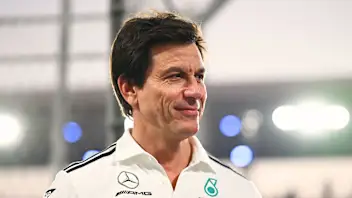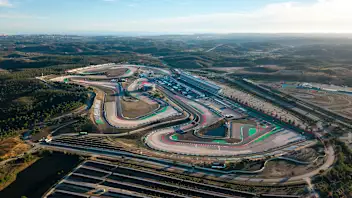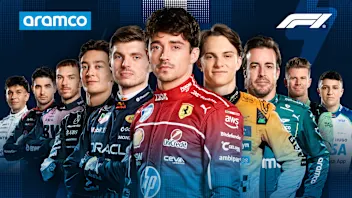The challenges of Singapore's Marina Bay Street Circuit are well established, but there's far more complexity to the only Formula One night race than what happens out on track. In addition to coping with the humidity and duration of the Grand Prix, teams and drivers all operate on European time in order to master the logistical challenges, meaning the surreal routine of going to bed near dawn - and having breakfast in the afternoon...
"The unique thing is that there's no jetlag, because we literally live there on European time. I go to bed at 5.00am - just as the sun is coming up I am going to sleep - and then at 2.00pm that's my wake-up time, so I go down and have breakfast when other people are having lunch. That's very strange..."
As surreal as Nico Rosberg's schedule for Singapore may seem, the itinerary is actually typical of the Formula One fraternity. Dealing with the only night race on the calendar (as opposed to the twilight rounds in Bahrain and Abu Dhabi) means far more than simply adjusting to racing under lights.
Because of the scheduling of sessions, the paddock operates in a strange form of limbo, completely out of sync with the local area. Gone is the idea that only the most committed revellers will still be partying at 6.00am, or that eating breakfast in the afternoon is odd: in Singapore, such routines are actively encouraged by the teams.
"It's a different philosophy," Marussia's chief engineer Dave Greenwood explains. "It is a bit bizarre when we have breakfast for example, but everything is based around the normal offsets to sessions - if the session starts at 6.00pm local time, for example, we work backwards to plan when we wake, when we eat, when we start work.
"It sounds odd, but after a number of years of doing it, it does work - in fact it's actually harder to move off one time zone onto another than it is to stay on European time through the week in Singapore. Making sure the guys can remain on UK time is therefore a big priority - so aspects like the timing of when we arrive are important."
It's not just flights either: when Red Bull's crew landed on Monday, they did so with an open remit for the evening. A late night, likely to be cracked down on by bosses during any other race weekend, is actually an efficient way to stick to the European timeframe.
"I never thought as a team manager I would say to my guys stay out," Red Bull's Jonathan Wheatley reflects, "but because the flights come in in the evening, the guys get there and can have a big night if they like for their first night in Singapore. They don't actually have to go to bed until 6 or 7 o'clock in the morning.
"Personally, I don't get any jetlag at all. I thought that the light would have a big effect on your body clock, but as long as the curtains are dark enough in your hotel room you'll be fine."
As with any race weekend, starting on the right note is essential. That's why, according to Wheatley, the first night is key - although, should one wake early, the gym and swimming pool are of course already open and provide a welcome way to wile away the ‘morning' hours.
Night becomes day, and that becomes the norm, but it brings with it a new set of problems. Finding a place to have dinner at daybreak is an obvious hurdle; avoiding being woken or disturbed by those operating on local time a fine - and refined - art.
"All the staff work on the offset hours, including the motorhome," Greenwood says of Marussia's preparations. "Most of our meals are therefore done at the track, so the hotel literally becomes a place to sleep - that's it. We do talk to the hotels however, as we have an arrangement for them not to clean our rooms until the evening, when we're back at the circuit.
"For the guys who have done it for a few years now it is fairly ingrained - they're used to it. We discuss it with the newer guys, those who haven't done the race before, but once you're there and into the swing of things, it becomes fairly normalised."
In fact, it even helps some processes - those working as real-time support from back at base in Europe, for example, are able to stick to their usual routines rather than rising in the middle of the night, while communicating with friends and family is also easier.
But mastering the F1 night world is not the only problem posed in Singapore. Extreme humidity, coupled with one of the longest Grands Prix of the year in terms of race time, exacts a punishing toll on drivers and team crews alike. That raises question marks about how easily teams can operate at their peak, even before the issue of unusual hours is taken into account. For some, it can be a draining experience - quite literally.
"In terms of drivers losing fluids, Singapore is always one of the highest," Greenwood says. "The figure often quoted is that they lose around 3kg of fluids: that's probably a little high, but we track these things and Singapore is always up there.
"The humidity is also there for the guys working on the cars. Luckily for the majority of the time you're working at night, so you don't have direct heat from the sun - as is the case in places like Malaysia. But it's vital to stay hydrated, so the team do quite a bit of work to give everybody guidance. When you are absorbed by a job, you can sometimes forget the basics, so as a team we look out for each other."
Even so, teams are operating under extraordinary circumstances - as Wheatley describes it: "It is very much like an oven in the garage."
In such sweltering conditions, an F1 team's collective ability to constantly perfect processes is essential. Small tweaks to things like the vividness of lights used to communicate with drivers - teams turn them down as the drivers use clear visors at Singapore - reflect the constant evaluations and assessments than underpin on-track success here.
"In general, in the early days of racing here, there were a lot of things that got thrown up as potential headaches: potential glare from pit boards was one I remember, as was the potential need to change team visors," Greenwood says. "Over time, as we've raced there more often, you become more aligned with the fact the lighting system is so good that it's almost like you are out in daylight. While the drivers go with a clear visor because of the glare, the issues to the pit crew are fairly minimal."
And so to the serious business - on-track at Marina Bay - and another odd dynamic arises. While the temperature and humidity are hardly conducive to engine performance, the fact that ambient and track temperatures are usually similar can actually aid cooling.
"Singapore doesn't tend to be one of our worst circuits of the year for cooling," Greenwood says. "The main thing is to keep the [charge] air going through the intercoolers as cool as possible, but that is a challenge we face at most other circuits. In reality, the fact the track and air temperatures are almost aligned means it is not particularly stressful."
Where Singapore does stand out for the cars is potential damage. Even at such an elite level, with the drivers operating at such physical extremes and with the unforgiving Marina Bay barriers rarely more than inches away, mistakes can be easy - it is no coincidence that every race so far here has featured at least one safety-car appearance.
"It's one of the circuits where we plan to have the highest stock levels of spares," says Greenwood. "Where we might take four suspension sets to a normal circuit, for example, here we'll bring five. We need to be as well stocked as possible, just in case the guys have a little tap with the walls while they're pushing…"
But as you can see, it is more than just 23 corners and 5.065 kilometres of closely confined tarmac that make Singapore such an unusual challenge. The extreme humidity and unusual hours form a punishing combination - which is why having breakfast in the afternoon can in some ways be just as important as anything the drivers do in the cockpit...
Next Up
Related Articles
 Piastri 'will be a world champion' in future – Norris
Piastri 'will be a world champion' in future – Norris Wolff calls Abu Dhabi ‘mediocre’ but ‘pleased’ to finish P2
Wolff calls Abu Dhabi ‘mediocre’ but ‘pleased’ to finish P2 3 inspiring individuals share their paths to working in F1
3 inspiring individuals share their paths to working in F1 Formula 1 to return to Portugal in 2027 and 2028
Formula 1 to return to Portugal in 2027 and 2028 Power RankingsWho did our judges rank as the best F1 driver of 2025?
Power RankingsWho did our judges rank as the best F1 driver of 2025?.webp) VOTE: Choose your favourite race of the 2025 season
VOTE: Choose your favourite race of the 2025 season